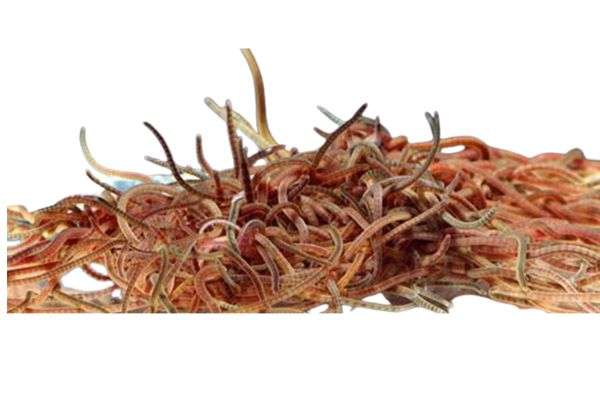Hey there, fellow worm enthusiasts! If you’ve ever wondered how to keep those fascinating black worms alive, whether you’re using them as bait for fishing or as pampered guests in your aquatic pet world, you’re in the right place. These wriggly wonders might seem simple, but there’s an art to ensuring they live their best lives. In this friendly and informative guide, we’re about to dive deep into the world of black worm care. So, let’s get ready to discover the secrets of keeping these little champs thriving!
Understanding Black Worms
Black worms, scientifically known as Lumbriculus variegatus, are small freshwater worms that have garnered attention for their versatility. It is also known as California blackworm. They are typically found in the mud or detritus of slow-moving freshwater bodies. These worms are highly prized in the world of aquaculture and angling due to their natural appeal to a wide range of aquatic species.

Image Showing Black Worms
Systematic Position
Phylum: Annelida
Class: Clitellata
Order: Lumbriculida
Family: Lumbriculidae
Genus: Lumbriculus
Species: Lumbriculus variegatus
Benefits of Using Black Worms
Using black worms as bait or as part of your pet fish‘s diet offers a multitude of benefits. These creatures are a nutritional powerhouse, packed with essential nutrients and proteins. Their natural, enticing movement in water makes them an irresistible treat for fish, enhancing their overall health and vitality.
Sourcing Quality Black Worms
Here are some tips to help you find top-notch black worms and avoid any potential pitfalls:
1. Reputable Suppliers: Begin your search by identifying reputable suppliers who specialize in providing healthy and vibrant black worms. Look for reviews and recommendations from fellow enthusiasts to gauge the quality of their products and service.
2. Local Pet Stores: Check with your local pet stores or aquarium shops. Some may carry live black worms, and purchasing locally can reduce stress on the worms during transportation.
3. Online Retailers: Many online retailers offer the convenience of ordering black worms from the comfort of your home. However, exercise caution and thoroughly research the seller’s reputation before making a purchase.
4. Caution with Collecting: If you plan to collect black worms from natural sources like ponds or streams, ensure that you have the necessary permits and adhere to local regulations. Be mindful of water quality and environmental impacts.
Creating the Ideal Habitat
Setting up a suitable habitat for black worms is a crucial step. A well-maintained container or tank is essential for their longevity. Ensure the substrate at the bottom of the container is fine and soft to mimic their natural environment. Maintain stable water conditions, keeping the temperature within the optimal range for these cold-water worms.
Feeding and Nutrition
To keep your black worms healthy and energetic, you must provide them with a balanced diet. These voracious eaters thrive on various food sources, including decaying plant matter, microorganisms, and organic detritus. Regular feeding ensures they receive the necessary nutrients for growth and reproduction.
Water Quality Maintenance
Maintaining clean and suitable water conditions is paramount. Regular water changes and effective filtration systems are vital to prevent the buildup of harmful substances and bacteria. Clean water is the cornerstone of a thriving black worm habitat.
Avoiding Overcrowding
Overcrowding can have adverse effects on the health of your black worms. Strive for an optimal worm-to-container ratio to prevent stress, competition for resources, and potential issues with water quality. Give your worms the space they need to flourish.
Handling Black Worms
When handling black worms, gentleness is key. Avoid stressing or injuring them during transfers to their feeding environment. Proper techniques, like using a soft mesh net or a gentle siphoning method, help ensure their well-being.
Managing Reproduction
Understanding the reproductive process of black worms is essential. Depending on your goals, you can encourage or control their reproduction. This knowledge allows you to maintain a consistent supply of live black worms.
Protection Against Contamination
Contaminants pose a significant risk to your black worm habitat. Implement quarantine procedures for new worms to prevent diseases and parasites from entering your ecosystem. Vigilance in this regard is crucial.
Regular Observation
Consistent monitoring of your black worms is key to their well-being. Keep records of their behavior, growth, and overall health to detect any changes early on. This proactive approach can prevent potential issues from spiraling out of control.
Harvesting Techniques
When it’s time to harvest your black worms for use as bait or pet food, follow safe and efficient methods.
Storage Options
For surplus black worms, explore short-term and long-term storage solutions. Techniques like refrigeration and moisture control will help extend the shelf life of these valuable creatures.
Frequently Asked Questions
Addressing common queries related to black worm care and maintenance, we’ll provide concise answers to common concerns, ensuring you have all the information you need at your fingertips.
Can I use tap water for my black worm habitat?
Answer: Absolutely, but with a few precautions. Tap water often contains chlorine, which can harm your black worms. To make it safe, simply treat the water with a dechlorinator before adding it to the habitat. This will ensure a healthy environment for your worms.
How often should I feed my black worms?
Answer: Black worms are hearty eaters, but moderation is key. Feeding them every 2-3 days with a small amount of finely crushed fish flakes or powdered spirulina is usually sufficient. Keep an eye on how quickly they consume the food, and adjust accordingly.
Can I keep black worms and other aquatic creatures together in the same tank?
Answer: It’s generally best to keep black worms in a separate container or culture tank. They may become a tasty snack for larger fish or amphibians, so maintaining a dedicated worm habitat is a safer choice.
What do I do if my black worms start to develop a foul odor?
Answer: A foul odor can be a sign of deteriorating water quality. First, check for any uneaten food or decaying matter in the habitat and remove it. Then, perform a partial water change, ensuring that the new water is properly conditioned and within the right temperature range. This should help eliminate the odor and improve the worms’ environment.
How can I encourage black worm reproduction if I want to cultivate them for the long term?
Answer: To promote reproduction, maintain optimal conditions in their habitat. Keep the water clean, maintain a consistent temperature, and ensure a balanced diet. Additionally, introducing fine-grain sand or silt at the bottom of their tank can provide a suitable substrate for egg-laying. With the right care, your black worms should reproduce naturally, providing a steady supply.
Concluding Remarks
In conclusion, black worm care requires diligence, attention to detail, and a passion for creating the ideal environment. By following the comprehensive guidelines provided in this article, you’ll be well-equipped to ensure the well-being and longevity of your black worm population. Happy worm-keeping!

